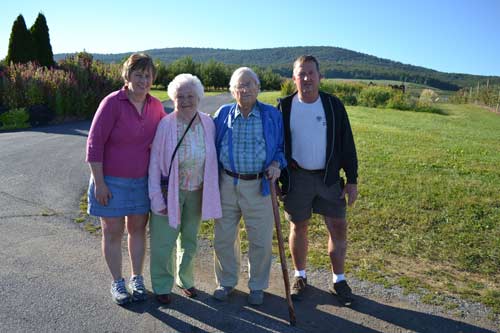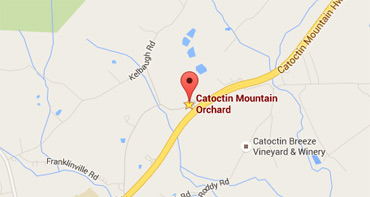The History of Orchards in Thurmont with Elmer “Lee” Black

Elmer “Lee” Black was born January 31, 1923, near Thurmont. He was the son of the late Willis G. and Maude Baker Black. He had a brother, Harry, and a sister, Betty. Due to the untimely death of their father when Harry was 16, Lee was 14, and Betty was 12, they all learned to work hard to help their mother during the 1930s when times were tough.
Many days were spent picking green beans at the Zentz Farm (now Rodman and Bobby Myers farm). Lee and Harry built a small chicken coop to raise and sell chickens and eggs. They took care of several bee hives to get honey for themselves and sold or bartered it. They cut, split, and sold cords of wood during the winter months for some income.
The boys would trap and skin small wildlife to get money for the pelts. When trapping skunks, you had to keep the skunk’s feet off the ground or it could spray. Lee remembered one time, when he was getting a skunk out of a trap, he held it by its tail while working the trap, but accidently got its back feet back on the ground and, got sprayed! When he got home his mother had to scrub him down in vinegar and tomato juice to get the smell off of him!
When Lee was a kid in the 1920s and 1930s, there were two places to get fruit around Thurmont. The first was a big orchard owned by Hooker Lewis on the hill behind where Cozy stood and before the highway went through. That land is now developed. About the same time, Johnny Kelbaugh had an orchard where Gateway Candyland is now. Harry Zentz was known for making cider at the time. Lee said that before he was born, most farmers and homesteaders had a small orchard of their own.
After graduating from Thurmont High School in 1940, Lee enlisted in the Army Air Corps. While serving with Headquarters Squadron 21st Air Service Group, he served as a photographer. During WWII, he was sent to the Asiatic-Pacific Theater, and was stationed in Australia and then New Guinea. He took thousands of photographs from the ground and air for Public Relations and History Reports in locations from New Guinea to Tokyo.
Discharged in 1945 after earning the rank of Staff Sargent, Lee then started a photography business in Thurmont and Emmitsburg.
Lee met his wife Frances, at the Monterey Tea House on New Year’s Eve. She was born and raised in Baltimore City. She said, “My prudish and strict mother left me with my promiscuous aunt and she took me along to a drinking place.” Frances was 16 at the time, Lee was 10 years her senior. Within three months, they were engaged and married. The year was 1949.
With a chuckle and glance at his wife, Lee said, “We’ve been together ‘off and on’ for 67 years.” This comment earned him a thump on the shoulder from his ‘Fannie’. Still smiling, he added, “I’ve had interesting things happen to me.”
Wanting to spend more time outdoors, Lee and Frances bought Hooker Lewis’ Strawberry Field in 1950 and started Blacks Hilltop Orchard. Hooker Lewis had several little orchards around Thurmont. Lee said, “During World War II and right after – nearly everyone who had an apple tree could make money from it. But after the war, you had to be good at making an orchard to stay in business.”
Lewis’ Orchard, Pryor’s Orchard, and the original Kelbaugh Orchard were the main orchards in the area. Over the years, different people bought parts of Kelbaugh’s Orchard. Russel Flanagan, who had been a mason, quit and went into the orchard business. Right after the war, Hooker Lewis’ son-in-law opened an orchard that is now Pryor’s Orchard. Galen Pryor of today’s Pryor’s Orchard is a great-grandson.
Lee enjoyed the independence of owning an orchard. All of his and Frances’ six children – two girls and four boys – worked the orchard by picking and thinning fruit.
Ira Kelbaugh, son of Kelbaugh Orchard’s originator, Johnny Kelbaugh, originally planted the orchard along Kelbaugh Road. Lee’s brother, Harry, worked for Ira during the war. When Ira semi-retired, he told Harry he would sell him the orchard. For years, Harry took care of the orchard for half the profit and eventually bought it.
Read more of this article here or read more of the orchard’s history here





Recent Comments